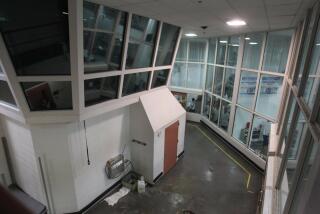Tim Russert: the details about what caused his death
- Share via
WHEN TV journalist Tim Russert died June 13, it was heartbreaking news for his family, friends and fans. Chief of the Washington bureau of NBC News and longtime moderator of “Meet the Press,” Russert was known for asking tough questions. He leaves two more: How could death come so fast to a man who, on-air and off, had always seemed so full of life? And couldn’t something have been done to prevent the tragedy?
What happened to Russert? According to reports, Russert died from sudden cardiac arrest -- his heart stopped working. This occurred when plaque ruptured in his left anterior descending coronary artery, a major vessel that supplies blood to the heart. Plaque is basically a mound of fat, cholesterol and other substances collected on an artery wall, often under its lining. When plaque ruptures, the body interprets it as an injury, and blood clots around it.
Clotting around ruptured plaque can spell big trouble, says Dr. Scott Monrad, director of the cardiac catheterization lab at Montefiore-Einstein Heart Center in New York City. In Russert’s case, the clot blocked his artery, cutting off blood to his heart and causing a heart attack -- the death of heart muscle tissue. Worse, the event disrupted his heart’s electrical impulses, making it lose its rhythm. This happens in about 15% of all heart attacks. Impulses can become too fast (ventricular tachycardia) or chaotic (ventricular fibrillation).
The latter happened to Russert. In fibrillation, “there’s no coordinated pumping,” says Dr. Marianne Legato, professor of clinical medicine at Columbia University in New York City. “Each cell is on its own, and the heart is in a shimmering, jelly-like state.”
Why did Russert have his heart attack just then, and why did it kill him? No one can say. A heart attack may or may not cause sudden cardiac arrest, which may or may not cause sudden cardiac death. “Russert had bad luck because his heart went into arrhythmia,” Monrad says, “but we don’t know who will, or when.”
What was Russert’s condition before his heart attack? He had been diagnosed with asymptomatic coronary artery disease -- his doctors knew he had some buildup of plaque in his coronary arteries, but he was not experiencing negative effects. This is not unusual: Of the men who die of coronary artery disease, more than half don’t show symptoms. Other times, Legato says, mild symptoms such as shortness of breath or pains in the back, neck or shoulders may be present but get ignored. Or circumstances that can reveal symptoms don’t arise. One of Legato’s patients never had shortness of breath because she never got exercise. (Russert got a lot.)
Some accounts say Russert had diabetes, and the autopsy found an enlarged heart. There’s no reason to believe his doctors knew this before.
How can coronary artery disease be monitored? On April 29, Russert had a stress test with “normal” results, his internist has said. It’s not clear what test this was -- there are several.
Standard treadmill tests measure heart rate, breathing, blood pressure and the heart’s electrical activity during exercise to determine how well the heart pumps blood. These tests can find arteries blocked by plaque, but only if the blockage is severe enough, typically 70% or more. Thus, minor blockages can sometimes be more dangerous than larger ones as they won’t be found by such tests or by symptoms, says Dr. Jignesh Patel, a clinical professor at UCLA.
Thallium stress tests use the radioactive substance thallium to trace blood flow to the heart muscle during exercise. Stress echocardiograms use sound waves to take motion pictures of the heart before and after exercise.
Other monitoring tests include basic echocardiograms -- stress echocardiograms without exercise; CT angiograms, which take precise pictures of coronary arteries; and coronary calcium scoring, which uses CT scanning to measure calcium deposits in coronary arteries. (These correlate with blockage risk.) Russert reportedly had at least one coronary calcium test, in 1998. His score, 210, ranks as “moderate” coronary disease.
When his heart attack occurred, what treatment did Russert receive? Reportedly, resuscitation attempts began immediately, and paramedics arrived quickly. They found that Russert wasn’t breathing and had no pulse and made three unsuccessful attempts at defibrillation in the ambulance on the way to the hospital. In this procedure, a device called a defibrillator shocks the heart in the hopes of restoring its normal rhythm.
Could more have been done? The best chance to save his life lay with defibrillation, says Dr. Paul Wang, chief of cardiac arrhythmia at Stanford University. But survival chances decrease about 10% for every minute that passes after cardiac arrest.
Automated external defibrillators -- portable and simple enough for children to use -- have been made available in many public spaces in recent years. In their first 10 months at Chicago’s O’Hare airport, such defibrillators were used on 14 people, reviving nine. Overall, when cardiac arrests are witnessed and these devices are readily available, they have a 50% success rate. But they cannot work miracles. “I don’t know if the studio [at NBC] had one,” Patel says, “but it sounds like it wouldn’t have made that much difference with the type of blockage Russert had.” Legato agrees: “I think he had a pretty horrible event,” she says. “Even if his doctor had been there, I’m not sure at all he could have been saved.”
Wang says Russert might have had a chance if he’d had an implantable defibrillator, which would have monitored his heart rate and rhythm and shocked his heart immediately if it detected arrhythmia. The devices have a more than 99% success rate. If doctors had been aware that Russert’s heart was enlarged, Wang says, “he might have been a candidate” for one.
Cardiac arrest is different from many medical problems that are protracted and debilitating, Wang says: Once resuscitated, people can continue to live a normal life. “We couldn’t make it happen this time,” he adds, but he sees Russert’s death as an opportunity to raise public awareness. “He wanted people to know the truth. He wanted to make our country better. And this tragedy could turn into something very powerful, so other families won’t have to go through this.”
For more on coronary artery disease risk factors, and whether Russert had them, go to latimes.com/cardiac.






